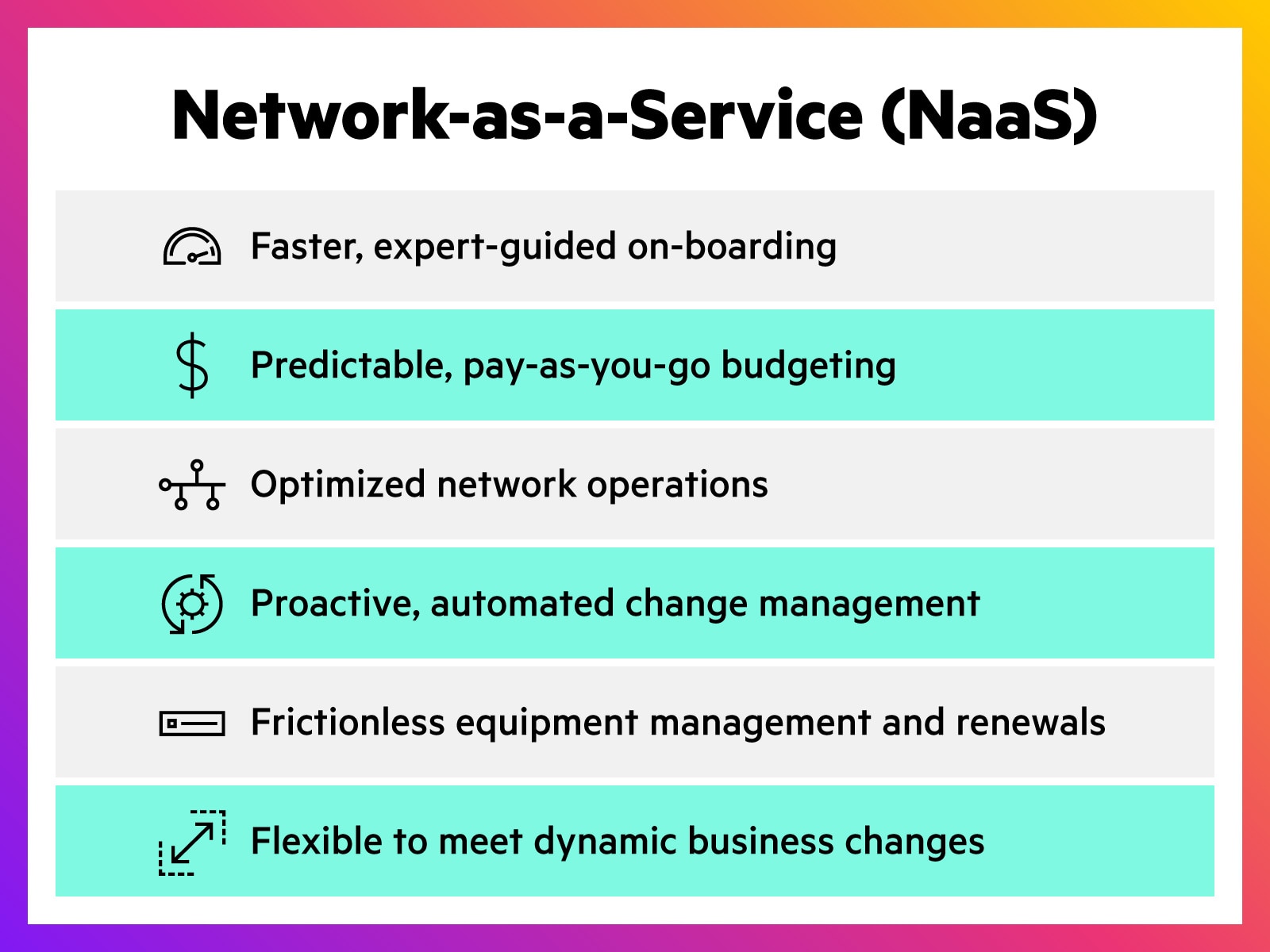
NaaS Was ist Network-as-a-Service (NaaS)?
NaaS ist definiert als die Hardware-, Software-, Service-, Management- und Lizenzierungskomponenten einer Netzwerkinfrastruktur, die in einem abonnementbasierten oder flexiblen Nutzungsmodell verwendet werden. Mit NaaS können Unternehmen die Bereitstellung, Netzwerkverwaltung, Wartung und Lebenszyklusverwaltung von Netzwerkinfrastrukturen auslagern.

- NaaS erklärt
- Wie funktioniert NaaS?
- Was sind die Unterschiede zwischen NaaS, IaaS und SaaS?
- Was bedeutet NaaS für Vertriebspartner?
- Warum sollte ich NaaS in Erwägung ziehen?
- Wird NaaS über Kapitalausgaben oder Betriebskosten finanziert?
- Unterstützt NaaS Nachhaltigkeitsbemühungen?
- Die Vorteile von NaaS
NaaS erklärt
Network-as-a-Service (NaaS) ist eine flexible Möglichkeit zur Nutzung der Netzwerkinfrastruktur von Unternehmen, mit der diese mit der Innovation Schritt halten, immer neue Geschäftsanforderungen erfüllen sowie die Netzwerkleistung und das Benutzererlebnis durch ein Cloud-ähnliches Abonnementmodell optimieren können.


Wie funktioniert NaaS?
Die Netzwerkinfrastruktur von Unternehmen wird traditionell über einmalige Kapitalausgaben für Hardware, Software, Lizenzen und Services genutzt, ob in einem Paket oder nicht. Mit NaaS können Unternehmen den gesamten Lebenszyklus der Unternehmensnetzwerkbereitstellung nutzen und optional auslagern. Sämtliche Hardware, Software, Lizenzen und Services werden mit einem flexiblen nutzungs- oder abonnementbasierten Angebot bereitgestellt, das in vielen Fällen als Betriebskosten verbucht werden kann.
Außerdem können Unternehmen mit NaaS die Planung, Bereitstellung und das tägliche Betriebsmanagement des Netzwerks auslagern, einschließlich Software-Upgrades, Überwachung und Fehlerbehebung sowie Stilllegung und Support am Ende des Lebenszyklus. Dadurch erhalten Unternehmen Zugang zur neusten und besten Technologie, während gleichzeitig das IT-Personal entlastet wird.
Was sind die Unterschiede zwischen NaaS, IaaS und SaaS?
Software-as-a-Service (SaaS) betrifft jede Softwareanwendung, die auf Abonnementbasis über die Cloud bereitgestellt wird. SaaS erstreckt sich über eine Vielzahl von Online-Anwendungen, die tagtäglich über das Internet genutzt werden.
Infrastructure-as-a-Service (IaaS) ist definiert als die Nutzung von Hardware- und Softwarekomponenten der IT-Infrastruktur wie Computing oder Datenspeicher in einem flexiblen nutzungs- oder abonnementbasierten Modell über die Cloud. Wie SaaS ist es eine allumfassende Kategorie, die das gesamte IT-Infrastrukturportfolio von Computing über Datenspeicher bis hin zu Netzwerken abdecken kann.
Network-as-a-Service (NaaS) unterscheidet sich von SaaS und IaaS dadurch, dass es viel spezifischer ist und sich unmittelbar nur auf die Netzwerkfunktionalität bezieht. Im Gegensatz zu SaaS und IaaS bezieht sich dieses Angebot nur auf Netzwerk-Hardware, -Software und -Services, die „Cloud-ähnlich“ über eine abonnement- oder nutzungsbasierte Abrechnung bereitgestellt werden. Manchmal wird der Begriff breiter definiert, sodass er den gesamten alltäglichen Betrieb und das Management einer Netzwerkumgebung durch Dritte, wie z. B. den Anbieter oder Vertriebspartner, umfasst.
Was bedeutet NaaS für Vertriebspartner?
Mit NaaS können Ihre Kunden Netzwerke in einer Cloud-ähnlichen Weise nutzen, d. h. durch monatliche Abonnementzahlungen mit flexiblen Verbrauchsoptionen. Darüber hinaus bietet es den Vertriebspartnern die Möglichkeit, gemeinsam Managed-Consulting-Services zu entwerfen, umzusetzen und zu erbringen, ohne sich zu Beginn des Kunden-Services Gedanken über eine Anzahlung machen zu müssen. Im Endeffekt hilft NaaS Partnern dabei, ihre Services schneller als je zuvor auf den Markt zu bringen.
Warum sollte ich NaaS in Erwägung ziehen?
Mit NaaS kann Ihr Unternehmen die Innovation beschleunigen durch:
- Schnellere Aktualisierung von Netzwerktechnologien durch Upcycling und/oder Recycling von Geräten.
- Schnellere Bereitstellung neuer Merkmale und Funktionen.
- Schritthalten mit den Anforderungen des dynamischen Ökosystems der Hardware- und Softwaretechnologien von heute.
NaaS bietet die notwendige Flexibilität, um den schnell wechselnden Geschäftsdynamiken gerecht zu werden, und zwar durch:
- Verringerung der erforderlichen Kapitalinvestitionen für große Bereitstellungen mit einem Abonnementmodell.
- Abbau von betrieblicher Komplexität durch ein auf Ihre Bedürfnisse zugeschnittenes Programm.
NaaS ermöglicht es Ihnen auch, das Know-how von Anbietern wie HPE Aruba Networking dazu zu nutzen, die Netzwerkleistung zu optimieren und die bestmögliche Benutzererfahrung zu bieten, und zwar durch:
- Beständige Überwachung der Leistung und Sicherheit, wodurch der Verwaltungsaufwand für Unternehmen mit Ressourcenproblemen sinkt.
- Proaktive Verwaltungsfunktionen mit Zugang zu hoch qualifizierten Netzwerkexperten, die eigens für Ihr Konto benannt werden.
- Bewährte Netzwerkdesigns und -konfigurationen, die in Zusammenarbeit mit Kunden und Branchenexperten entwickelt wurden.
Wird NaaS über Kapitalausgaben oder Betriebskosten finanziert?
NaaS bietet Bilanzflexibilität. Obwohl es in erster Linie auf die Betriebskosten mit einem Abonnementmodell ausgelegt ist, sind alle Rechnungslegungsverfahren zwischen Unternehmen verschieden. NaaS wird häufig als ein OPEX-Modell aus der CIO-Perspektive unterstützt, indem NaaS auf ein operatives IT-Budget ausgerichtet wird. Aus der Sicht des CFO handelt es sich in der Regel um eine Frage im Zusammenhang mit den Jahresabschlüssen. Der Vorteil von NaaS besteht darin, dass es sich um einen nutzungsbasierten Vertrag handelt, der Services unter OPEX-Gesichtspunkten bereitstellt. Ein einfaches NaaS-SKU, das mit einer as-a-Service-Lösung verknüpft ist, könnte beispielsweise aus Betriebskostensicht leichter genutzt werden.
Unterstützt NaaS Nachhaltigkeitsbemühungen?
Nachhaltigkeit steht bei vielen fortschrittlichen Unternehmen im Vordergrund. Umweltbedenken nehmen angesichts der kürzeren Lebenszyklen und der größeren Menge an Technologieabfall weiter zu. Die Entsorgung von IT-Assets (IT Asset Disposition, ITAD) kann recht teuer sein. Viele Unternehmen verwalten veraltete Hardware in Lagern, weil sie befürchten, dass beim Recycling von Hardwarekomponenten Firmen- oder persönliche Daten verloren gehen könnten. Effektive NaaS-Programme können diese Sicherheits- und Kostenängste beseitigen. Eine Wiederverwendung von Geräten und deren ordnungsgemäße Entsorgung sind wichtig, aber kostspielig. Eine nachhaltige Wiederverwendung und Entsorgung gehören zu den wichtigsten Eigenschaften eines NaaS-Angebots und ermöglichen es Unternehmen, ihre Nachhaltigkeitsziele einfacher zu erreichen.
Die Vorteile von NaaS
- Finanzielle Flexibilität: Für Unternehmen baut NaaS traditionelle finanzielle Hürden ab und bietet eine Alternative zu Vorabinvestitionen. Die Möglichkeit zur bedarfsorientierten Bezahlung ist einer der Hauptvorteile von NaaS. Dank der flexiblen Finanzierung können Unternehmen auf das dynamische Geschäftsklima von heute, mit oftmals schnellen Veränderungen, eingehen.
- Verbesserte Sicherheit: Durch eine schnellere Bereitstellung neuer Features und Funktionen lässt sich die Sicherheit für NaaS verbessern und sicherstellen, dass sich das Netzwerk in einem einwandfreien Zustand befindet. NaaS bietet die Möglichkeit, Branchenanforderungen zu erfüllen, um neue Services und Funktionen schneller einzuführen. Erweiterte Services sorgen für eine optimale Leistung und schützen Unternehmen vor Schwachstellen durch veraltete Ausstattung oder Konfigurationen.
- Proaktives Management: NaaS-Bereitstellungen mindern Performance- und Sicherheitsrisiken durch proaktive Beratungs- und Verwaltungsfunktionen. Zu den proaktiven Verwaltungsfunktionen gehören häufig AIOps (AI for IT Operations)-gestützte Informationen oder hochqualifizierte Netzwerkexperten, die sicherstellen, dass das Unternehmen durch die neuesten Produktmerkmale, Funktionen oder Konfigurationen das Beste aus seiner Implementierung herausholt. Dieser proaktive Verwaltungsansatz soll die Leistung und Prozesse optimieren sowie Probleme beheben, bevor sie Ausfälle verursachen.
- Skalierbares, zentralisiertes Management: Die Cloud-Management-Funktionen von NaaS ermöglichen ein kohärentes Management von Netzwerkdomänen (Rechenzentren, Enterprise Campus und WAN), sodass Unternehmen Netzwerke problemlos skalieren können. Managed Services können ergänzend bereitgestellt werden, um den gesamten Netzwerkbetrieb zu überwachen.
- Nachhaltigkeit: Effektive NaaS-Angebote tragen auch dazu bei, Bedenken im Zusammenhang mit der Sicherheit und den Kosten alter Hardware-Ressourcen zu zerstreuen. Eine Wiederverwendung von Geräten und deren ordnungsgemäße Entsorgung sind wichtig, aber kostspielig. Eine nachhaltige Wiederverwendung und Entsorgung gehören zu den wichtigsten Eigenschaften eines NaaS-Angebots und ermöglichen es Unternehmen, ihre Nachhaltigkeitsziele einfacher zu erreichen.
